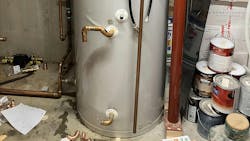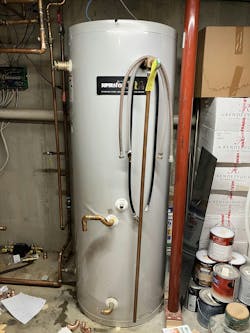Before my intestinal surgery, I met a contractor and his helper to go over a small high efficiency hot water boiler installation. Turned out that both had the same type of surgery for different (other than cancer) reasons. The helper’s was done when he was a kid and everything is fine. The contractor was about 9 – 10 months out from his surgery and was also doing fine. Nice news to hear before it’s your turn on that very narrow surgery table.
The contractor recently called to look at this job that he didn’t install but wanted some advice. We have a bond through surgery, so we set up a time. The homeowner greets me in the driveway and calls me “the rock star of hydronics.” He seems like the jovial type, always trying to get a joke in every conversation. We all walk to the basement while he’s going on about how bad the system performs.
Familiar Handiwork
The photo is of what I first saw, the boiler and the other zones are around the corner to the left. If you look closely, the tank was disconnected by the contractor that put in a high efficiency combination boiler. I won’t mention the brand because it wasn’t their fault that it didn’t work to the homeowners’ satisfaction.
Now I’m being told that there was an early adoption high efficiency boiler that was original with the house and piped to the indirect-fired water heater. I then realized that this was probably designed by a former workmate when he was at a different supply house. When I finally got around the corner, I could see his style and what was left and what was changed.
The new contractor’s crew that put in the combi boiler—which came with the low loss header and internal boiler loop pump—hooked up the space heating supply and return piping correctly to the low loss header. They disconnected the indirect-fired water heater from the existing boiler system piping and ran a cold water feed to the combi. The hot water from the combi was piped directly to the existing hot water main feeding the house.
This house has a dedicated re-circulation line with pump because the soaking tub is on located on the opposite side of the house. It was piped into the cold water feed, but set to run continuously to keep it warm and have hot water right away in the primary bath. The main complaint, I was told, was that his wife can’t fill the tub with hot water. With what I had seen so far, I doubted that it could.
Capacity and Flow
This combi boiler has the capacity to heat water continuously if it senses flow in the domestic water system, like a faucet or shower. That amount of flow through the boiler is usually set with some kind of flow restrictor. The assumption we make to figure out that flow rate is the temperature rise. I use 80 degree F, or raising water from 40 degree F to 120 degree F. The input on this boiler is 199,000 btu, output around 185,000 btu. We take that ouput and divide by 8.3 (weight of a gallon of water) then by 60 (minutes in an hour) and then the temperature rise. That comes out to about 4.5 gallons per minute that the combi can maintain when the water is real cold coming out of the ground in the middle of winter.
I noticed that there wasn’t a flow restrictor installed, but there was a ball valve that we could adjust. Through a little trial and error, we got the flow adjusted so that it could maintain hot water draw at the tub. Or at least that was until we went to the tub. Yes, it was at the right temperature, but the fancy out of the ceiling tub spout is designed for 10 gpm. It shoots a tight stream of water at 10 gpm, but breaks up at only 4.5 gpm. This takes us back to the information provided during the design that a 120 gallon indirect fired water heater can store enough hot water to fill the 100 gallon tub at the required 10 gallons per hour, or what we call the dump load.
I proposed that the indirect heater would have to be hooked up to the boiler as a space heating zone to be able to allow the woman of the house to have the tub ready for therapy. I quoted the contractor the parts he would need. The homeowner agreed to the concept and I came back to help with laying out the piping. The contractor pointed out that the combi was only rated for 120,000 btus for space heating, which will take more time to recover the tank temperature. He checked with the homeowner, who was trying to get a settlement from the contractor that put in the combi. Maybe a new boiler was going to be provided…
Shower Trouble
I came back when it was re-piped. Everything looked good and the tank was coming up to temperature when I left. We got it back to original design, except for boiler output. I was waiting for the call the next morning to find out if the woman of the house had a nice therapy soak in the tub. When I got the call, the complaint was now about the shower. She ran out of hot water after about 20 minutes, with a shower flow of 6 gpm. That’s easy math. The tank is drained and the low output of the boiler can’t keep up.
If I was told at the beginning that we needed to have continuous 6 gpm to take an hour-long shower, I would have gone another direction with the repair/upgrade. Two 199,000 btu instantaneous hot water heaters for the domestic side and a small boiler for his small radiant zones would be an option. Right now, I have quoted a 285,000 btu boiler to pair with the indirect. On paper, that combination can fill the tub easily or provide a warm shower for almost an hour.
Patrick Linhardt is a forty-year veteran of the wholesale side of the hydronic industry who has been designing and troubleshooting steam and hot water heating systems, pumps and controls on an almost daily basis. An educator and author, he is currently Hydronic Manager at the Corken Steel Products Co.
About the Author
Patrick Linhardt
Patrick Linhardt is a forty-one-year veteran of the wholesale side of the hydronic industry who has been designing and troubleshooting steam and hot water heating systems, pumps and controls on an almost daily basis. An educator and author, he is currently Hydronic Manager at the Corken Steel Products Co.

